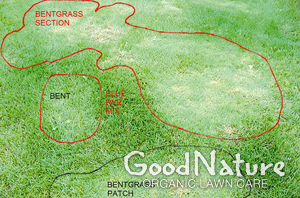 Loading... Please wait...
Loading... Please wait...Categories
Popular Brands
Our Newsletter
Bentgrass
What is Bentgrass?
Bentgrass is a cool season grass grows rapidly in cool wet conditions. You’ll see it often on golf course greens because it tolerates very low mowing. In the spring it spreads quickly and crowds out other grasses. As soon as the warm summer comes, it usually turns brown and plays dead...especially in full sun. The problem here is that many times other grasses you have in your lawn won’t turn brown, so it seems like something more is wrong. Another issue is that while the bentgrass is dormant and annual weeds take its place
Why do I have Bentgrass?
Many older lawns were seeded with bentgrass back in the day and once it is somewhere it is difficult to completely eliminate. There are certain conditions that are favorable to bentgrass. By providing those conditions, you encourage it to sprout and take over. Bentgrass likes cool moist conditions. So if you water everyday, you’re making the conditions favorable for bentgrass, which is more shallowly rooted than other turfgrasses. Other grasses have roots that can go down deeper for water. So, by watering less frequently and deeper, you’re making the conditions more favorable for the grasses that you’re trying to encourage and less favorable for the bentgrass. Bentgrass can also tolerate very close (short) mowing. So, if you cut the grass too short, you’re going to be creating conditions that favor bentgrass and make it more difficult for the grasses you’re trying to encourage to survive.
What can I do about Bentgrass?
If you just have small patches, it might be possible to either dig them out and reseed or kill them with glyphosate and reseed. One thing that we notice though is that the bentgrass is always spread more in the lawn than it appears at first glance. If you have a patch of solid bentgrass that is 1 foot in diameter, you’ll usually have a circle around it that is a mix of desirable grasses and bentgrass that is 3 times the diameter of the original patch. This makes killing spots and reseeding difficult.
Once the bentgrass takes over, usually the choices are to either eliminate it and start over, or to work with what you’ve got. If you’re going to work with what you have, then you need to start managing to promote bentgrass instead of discourage it. If this is the case, we recommend shifting your focus from fertility to pest control. To promote healthy bentgrass you’ll want to use just about any natural insect or disease suppression technique that you can to keep it healthy. We recommend applying beneficial nematodes in the spring and fall, using our natural fungicide alternative Greens Guard, and applying compost tea and garlic throughout the season. You’ll also want to water more often than normal (every other day and even daily in the summer, but almost always in the morning or heat of the day). Water in the morning to satisfy the plants thirst and in the middle of the day (briefly) to cool it down and reduce heat stress. Aerate and verticut regularly to keep thatch from building up.





